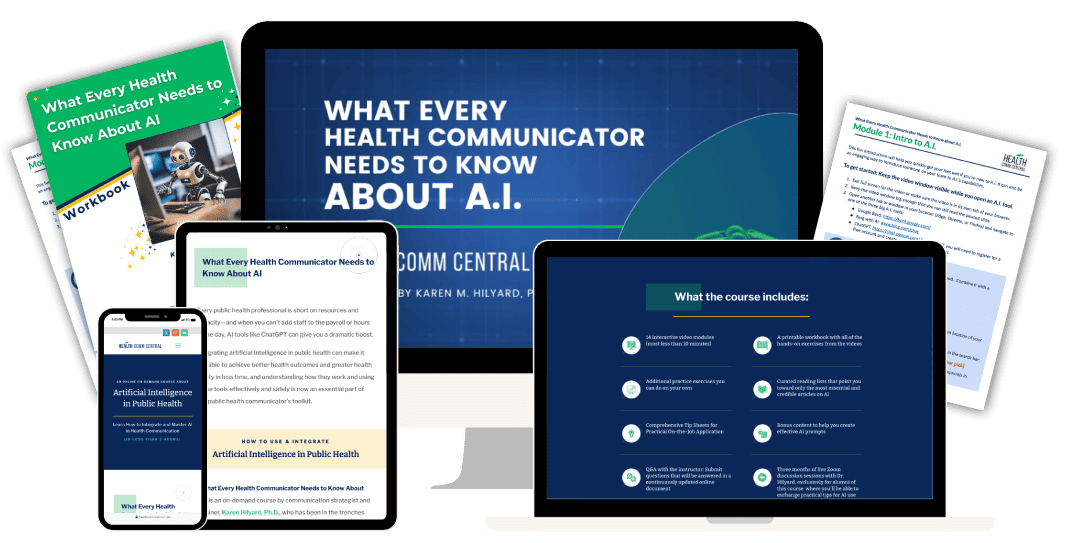Core Live Courses:
View Course Details
From the 4Ps of marketing to audience segmentation, positioning, strategic planning, and creative brief design. In just two days participants develop an entire public health marketing campaign. One of our most popular courses at CDC and everywhere it’s been offered!
Communicating Numbers & Statistics
View Course Details
View Course Details
Behavior Change Theories
View Course Details
Developing Effective Messages
View Course Details
View Course Details
View Course Details
This course will introduce the five key mindsets of design thinking and apply them to public health communication.
What Health Communicators Need to Know about SDOH
View Course Details
Limited-Time Courses:
Putting Social Norms to Work
View Course Details
Using relevant case studies and research-based techniques, you’ll learn how to leverage positive norms and minimize the impact of negative ones, as well as the steps for changing norms over time.
Power of Habit
View Course Details
Using the science around prompts, cravings, routines, responses, rewards, and restructuring environments, this course provides practical steps for improving the effectiveness of health interventions.
Persuasion Theories
View Course Details
You’ll learn how to select and apply theories, frameworks, and constructs that achieve the persuasive impact you need.
Diffusion of Innovation
View Course Details
This course teaches practical techniques to take an idea from a few initial adherents to large majorities of the population.
View Course Details
Effective health communication begins with knowing your audience. This course will help you identify audience segments for a particular health issue, understand their attitudes, needs, values, and barriers.
You’ll leave with tools and job aids that help you align messages, delivery channels, products, and services with audience personas, to motivate and support behavior change.
Entertainment Education
View Course Details
This course explores how health communicators can use both planned and unplanned entertainment programming and other media such as video games, novels, and podcasts to drive home health behavior change messages.
View Course Details
Includes hands-on practice with data collection techniques; instrument development, analysis, and interpretation of results, plus how to disseminate and your findings and apply them to health communication initiatives.
Research Instrument Development
View Course Details
This course covers the rules of instrument development and provides practice developing three common types of instruments.
Designing Your Life
View Course Details
You’ll learn five key mindsets of design thinking (curiosity, awareness, bias to action, reframing, and radical collaboration) and how to use them to design the life (and career) you want.
Strategic Communication Planning
View Course Details
Exercises include how to research and write a situation analysis, conduct a SWOT analysis, develop appropriate goals, objectives, strategies and tactics, and how to build evaluation of the plan’s success into your everyday practice.
Plain Language Communication
View Course Details
This hands-on training will change the way you communicate with tools and techniques to translate your words into conversational and accessible plain language.
Crisis & Emergency Risk Communication
View Course Details
Delivered by a CDC-certified CERC trainer with years of experience in both public health and coverage of breaking news , this course provides practical, research-proven formulas and best practices for public health communication.
Coping with Hostile Audiences & Anti-Science Beliefs
View Course Details
Using frameworks like the Radical Conversation Cycle and the Spectrum of Allies, this course teaches practical and effective ways to neutralize hostility and persuade hesitant audiences to “follow the science.”
View Course Details
No matter how much you think you know about PowerPoint, your next presentation will be transformed by the new tricks you learn in this session, which was an instant hit at CDC!
New Online On-Demand Course | Enroll Now
What Every Health Communicator Needs to Know About AI
